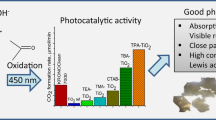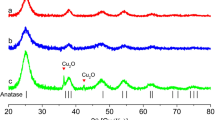Abstract
IR spectroscopy combined with thermogravimetry was used to investigate the effect of the pretreatment temperature on the degree of coverage of the surface of oxide photocatalysts, TiO2, ZnO, CeO2, and Zn2+/TiO2, with water. At room temperature, the amount of adsorbed water per unit area of photocatalysts in the air decreases in the row: ZnO ≥ CeO2 > TiO2, whereas the temperature needed for complete removal of physically adsorbed water from the studied oxides decreases in the reverse order. Water is removed from the ZnO surface by evacuation at room temperature; in the case of CeO2 and TiO2, it desorbs at 200 and 300 °С, respectively. The terminal OH groups on the oxide surface are the most strongly bonded with adsorbed water. In the zinc modified TiO2, the terminal OH groups are firstly replaced by Zn cations, which causes both hydrophobization of the samples under atmospheric conditions and a decrease in the temperature at which physically adsorbed water is released from the surface. Evacuation of ZnO at 350 °C removes the surface oxygen and results in the generation of the surface defect sites. This causes strong absorption in the IR spectra in the region of 1000—4000 cm–1. The formation of surface defects probably causes the appearance of donor levels in the band gap. The energy of the transition of electrons from these levels to the conduction band corresponds to the energy of the IR radiation. After oxidation of such samples in O2 at 350 °C, strong absorption in the IR spectra disappears.
Similar content being viewed by others
References
M. R. Hoffmann, S. T. Martin, W. Choi, D. W. Bahnemann, Chem. Rev., 1995, 95,69.
S. Sato, T. Kadowaki, J. Catal., 1987, 106,295.
K. Tanaka, G. Blyholder, J. Phys. Chem., 1972, 76, 1807.
T. N. Obee, R. T. Brown, Environ. Sci. Technol., 1995, 29, 1223.
M. Shen, M. A. Henderson, J. Phys. Chem. C, 2012, 116, 18788.
C. A. Walenta, S. L. Kollmannsberger, J. Kiermaier, A. Winbauer, M. Tschurl, U. Heiz, Phys. Chem. Chem. Phys., 2015, 17, 22809.
C. E. Nanayakkara, W. A. Larish, V. H. Grassian, J. Phys. Chem. C, 2014, 118, 23011.
J. M. Coronado, A. Javier Maira, A. Martínez-Arias, J. C. Conesa, J. Soria, J. Photochem. Photobiol. A, 2002, 150,213.
H. Einaga, S. Futamura, T. Ibusuki, Environ. Sci. Technol., 2001, 35, 1880.
H. Einaga, M. Harada, S. Futamura, T. Ibusuki, J. Phys. Chem. B, 2003, 107, 9290.
P. C. K. Vesborg, J. L. Olsen, T. R. Henriksen, I. Chorkendorff, O. Hansen, Chem. Eng. J., 2010, 160,738.
D. V. Barsukov, A. N. Pershin, I. R. Subbotina, J. Photochem. Photobiol. A, 2016, 324,175.
F. Boccuzzi, C. Morterra, R. Scala, A. Zecchina, J. Chem. Soc., Faraday Trans., 1981, 2, 2059.
K. H. Rieder, M. Ishigame, L. Genzel, Phys. Rev. B, 1972, 6, 3804.
T. Berger, M. Sterrer, O. Diwald, E. Knözinger, D. Panayotov, T. L. Thompson, J. T. Yates, J. Phys. Chem. B, 2005, 109, 6061.
F. Boccuzzi, G. Ghiotti, A. Chiorino, J. Chem. Soc., Faraday Trans. 2, 1983, 79, 1779.
A. A. Tsyganenko, V. N. Filimonov, J. Mol. Struct., 1973, 19,579.
K. Atherton, G. Newbold, J. A. Hockey, Discuss. Faraday Soc., 1971, 52,33.
M. Primet, P. Pichat, M.-V. Mathieu, J. Phys. Chem., 1971, 75, 1216.
M. Nagao, J. Phys. Chem., 1971, 75, 3822.
W. Hirschwald, Curr. Top. Mater. Sci., 1981, 7,148.
D. Raymand, A. C. T. Van Duin, W. A. Goddard, K. Hermansson, D. Spangberg, J. Phys. Chem. C, 2011, 115, 8573.
M. Schiek, K. Al-Shamery, M. Kunat, F. Traeger, C. Wöll, Phys. Chem. Chem. Phys., 2006, 8, 1505.
Author information
Authors and Affiliations
Corresponding author
Additional information
Published in Russian in Izvestiya Akademii Nauk. Seriya Khimicheskaya, No. 10, pp. 1847—1853, October, 2017.
Rights and permissions
About this article
Cite this article
Barsukov, D.V., Subbotina, I.R. IR-study of hydrated surface of oxide photocatalysts. Russ Chem Bull 66, 1847–1853 (2017). https://doi.org/10.1007/s11172-017-1956-8
Received:
Revised:
Published:
Issue Date:
DOI: https://doi.org/10.1007/s11172-017-1956-8




